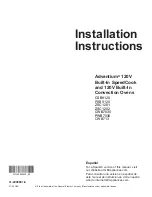
LABO VEN S.IN S.7-18.wpd
13 of 23
07/18
6
SAFETY EQUIPMENT
6-1
Practically all explosions and fires in ovens can be traced back to human error. It
should be noted that:
6-1.1
For the protection of personnel and property, careful consideration should be given
to the supervision and monitoring of conditions that could cause, or could lead to, a
real or potential hazard on any installation.
6-1.2
The presence of safety equipment on an installation cannot, in itself, ensure
absolute safety of operation.
6-1.3
There is no substitute for a diligent, capable, well-trained operator.
6-1.4
Highly repetitive operational cycling of any safety device can reduce its life span.
6-2
Thermostats, switches and electric relays should not be used as substitutes for
electrical disconnects or unplugging equipment.
6-3
Regularly scheduled inspection, testing, and maintenance of all safety devices shall
be performed. (See Section 7 - Maintenance and Appendix B - Minimum Periodic
Maintenance Report)
6-4
Safety devices shall not be removed or rendered ineffective by bypassing them
electrically or mechanically.
6-5
All units are equipped with an excess temperature limit interlock. Operating at
temperatures above the setting of this device will result in opening the circuit to the
heating elem ents. These devices must be replaced or reset before power will be
restored to the heating elem ents. These devices are installed to protect the oven
from a runaway condition. It is the users responsibility to monitor any product in the
oven if over-heating can cause damage to the product or cause a fire. The cause of
over-heating should be determined and corrected before processing is continued.
Do not remove or bypass excess temperature limit interlock.
6-5.1
One-time excess temperature limit interlock (standard on Models LO-201C and
LW -201C) is installed in series with the oven thermostat. If the oven runs over
maximum temperature, the excess temperature limit interlock will open the circuit
to the heating elements. The excess temperature limit interlock and lead wire must
be replaced after this happens. The excess temperature limit interlock cannot be
reset.
6-5.2
Non-adjustable manual reset excess temperature limit interlock (standard on Model
LR-271C) will trip at approximately 50
E
F above the maximum operating
temperature of the oven. This device is reset by depressing the red button located
on the rear of the oven.
6-6
No matter how much safety equipment is provided on the oven, it cannot protect the
operator, other personnel or property from unsafe conditions caused by poor
judgement or m isapplication. Common sense must be used for safe operation. If in
doubt, contact the factory. Check the process periodically to ensure oven is being
used as originally intended.









































